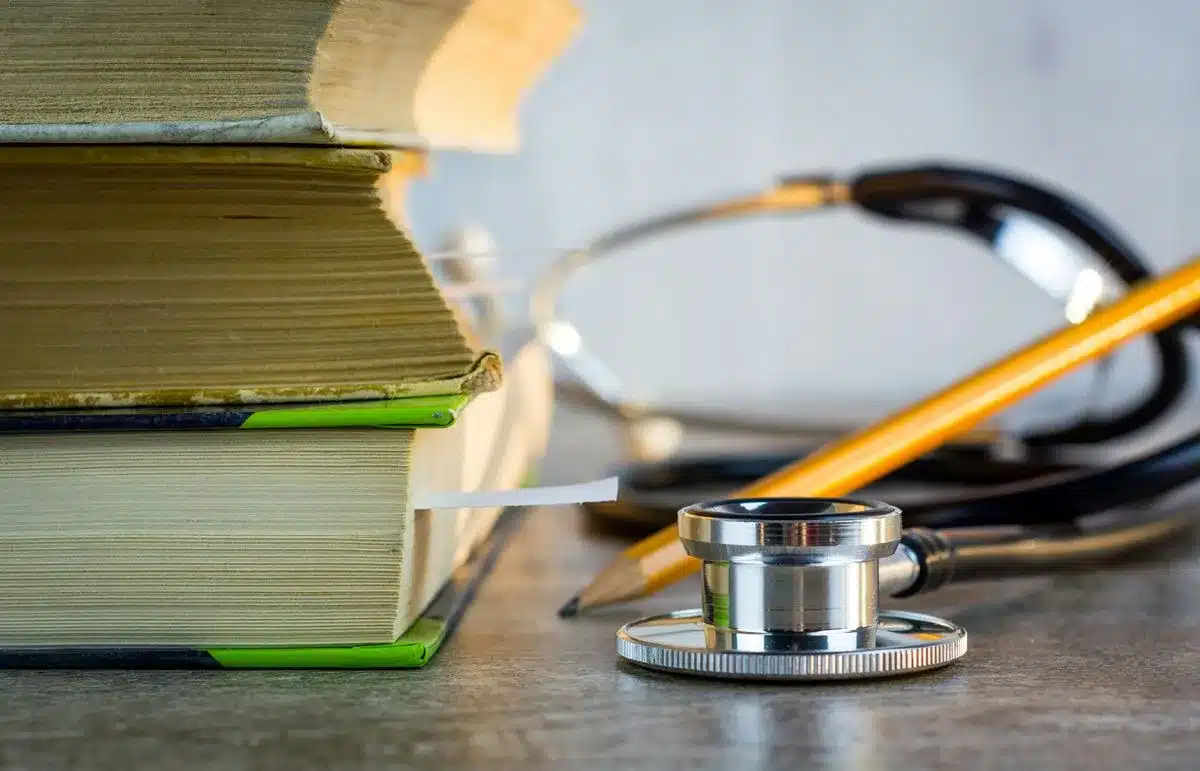Embarking on the journey from MBBS to MD in the United States is a significant step for Indian students aspiring to specialize in medicine. This article provides an insightful guide on navigating the pathway to postgraduate medical education in the USA, highlighting the differences between Indian and American medical systems, the application process, strategic planning, and financial considerations. It offers a roadmap for Indian students to achieve their dream of practicing medicine in the USA, with a focus on the USMLE steps, Fast Track MD programs, and scholarship opportunities.
Key Takeaways
- Understanding the differences between MBBS in India and MD in the USA is crucial for Indian students aiming for medical specialization in America.
- Preparation for USMLE Steps 1, 2, and 3 is the gateway to postgraduate medical education and residency in the USA.
- Strategic planning, including early USMLE preparation and gaining clinical experience, is vital for a successful application to PG medical colleges.
- Indian students must navigate the application process meticulously, balancing reach, match, and safety schools, and stay on top of financial planning.
- The Fast Track MD program offers an alternative pathway to specialization in the USA, with the added benefit of global recognition and higher salary prospects.
Understanding the MBBS to MD Pathway in America

Comparing PG Medical Education in India and the USA
The journey to becoming a doctor in the USA is markedly different from the path in India. The primary difference lies in the program duration and the level at which students begin their medical education. In India, students can start their MBBS immediately after completing their 12th standard, which includes a 5.5-year program with an internship. Conversely, in the USA, medical education commences at the postgraduate level after completing a bachelor’s degree, leading to an MD degree over a span of 4 years, excluding pre-med studies.
Another key difference is the entrance examination. Indian students must clear the NEET exam to secure a seat in an MBBS program, whereas in the USA, the MCAT is a common requirement for MD programs. However, some pathways, like the Fast Track MD Program, allow students to bypass the MCAT. Additionally, the cost of education and living expenses in the USA are generally higher, but the MD degree offers global recognition and potentially higher salary prospects.
To practice in India after earning an MD from the USA, graduates must pass the Foreign Medical Graduate Examination (FMGE). This step ensures that the medical education and skills acquired abroad meet the standards required in India. The table below summarizes the key differences:
| Criteria | MBBS in India | MD in the USA |
|---|---|---|
| Duration | 5.5 years (including internship) | 4 years (excluding pre-med) |
| Entrance Exam | NEET | MCAT (varies for some programs) |
| Recognition | Limited | Global |
| Initial Salary | 5-10 lakhs/year | 1.8-2.5 crores/year |
The MD degree not only signifies a high standard of medical education but also serves as a passport to international healthcare arenas.
Eligibility and Admission Criteria for Indian Students
Indian students aiming to pursue an MD in the USA must meet specific eligibility criteria, which serve as the foundation for their medical journey. A strong science background is essential, typically demonstrated by 12th-grade results. Additionally, proficiency in English is a prerequisite, often validated by standardized tests like TOEFL or IELTS.
Eligibility Criteria:
- Completion of 12th grade with a focus on science subjects
- Proficiency in English (TOEFL/IELTS scores may be required)
- Minimum GPA and pre-medical coursework (varies by program)
The admission process for MD programs in the USA is highly competitive, focusing on academic excellence and a well-rounded profile. Early preparation and understanding of the specific requirements of your chosen university are crucial.
Indian students pursuing MBBS to MD in the USA face eligibility criteria, competitive admissions, and two main pathways: USMLE route and Fast Track MD Program for residency match success. Strategic planning, including early preparation, understanding the admission criteria, and avoiding common mistakes, is crucial for success in US medical school applications. Financial planning is essential, as the cost of medical education in the USA is high; however, scholarships and financial aid can help mitigate these expenses.
USMLE Steps: The Gateway to Medical Specialization
The United States Medical Licensing Examination (USMLE) is a pivotal series of exams that Indian MBBS graduates must navigate to practice medicine in the USA. Passing the USMLE Steps 1 and 2 is essential for securing a residency match, which is the cornerstone of medical specialization in America. The USMLE not only assesses a candidate’s knowledge and skills but also their readiness to enter clinical practice.
Eligibility for the USMLE requires a strong foundation in medical sciences, and Indian students often find that early preparation is key. Here are the steps to take:
- Thoroughly understand the USMLE format and content
- Create a study plan that covers all the necessary material
- Engage in clinical rotations or observerships in the US to gain practical experience
- Take practice exams to assess readiness and identify areas for improvement
The journey through the USMLE can be arduous, but it opens doors to diverse career opportunities and global recognition. Indian students can pursue a Fast Track MD Program in the USA, facing high costs but benefiting from global recognition and diverse career opportunities.
Financial considerations are also crucial, as the cost of USMLE preparation and the subsequent steps can be significant. However, the investment can lead to a rewarding career in the highly esteemed US healthcare system.
Navigating the Application Process for PG Medical Colleges

Key Documents and Deadlines for Applicants
Securing admission to a PG medical college in the USA is a meticulous process that demands careful preparation of key documents. The application packet must include academic transcripts, letters of recommendation, a personal statement, and proof of English proficiency. For Indian students, these documents not only demonstrate academic prowess but also the ability to thrive in a different educational culture.
The following list outlines the essential documents required for the application process:
- Academic transcripts from MBBS or equivalent degree
- Letters of recommendation (minimum of three)
- Personal statement outlining career objectives and motivation
- Curriculum Vitae (CV) detailing academic and clinical experiences
- English proficiency test scores (TOEFL or IELTS)
- USMLE Step 1 and Step 2 CK scores
Adherence to application deadlines is critical. Most U.S. medical colleges have deadlines between September and November for the following academic year. It is advisable to start the visa application process early, as it can be time-consuming.
Early preparation and organization are the bedrocks of a successful application. Utilize organizational tools to keep track of deadlines and ensure that no component of your application is overlooked.
Visa Application Tips for Indian Students
Securing a student visa is a pivotal step in your journey to pursue PG medical education in the USA. Start the visa application process early to allow ample time for any unforeseen delays or additional documentation requests. Here are some practical tips to enhance your visa application experience:
- Ensure all your documents are in order, including acceptance letters, financial support evidence, and academic records.
- Practice for the visa interview, focusing on clear and concise answers about your study plans and future aspirations.
- Familiarize yourself with the visa regulations and maintain updated knowledge on any changes that could affect your application.
A well-prepared visa application reflects your commitment and organization, qualities that are essential for a medical professional.
Remember to check the official embassy or consulate website for the most current information and guidelines. Utilizing consultancies or advisory services can also provide additional support and clarity throughout the visa application process.
Acceptance and Post-Application Communication
Upon receiving an acceptance letter from a PG medical college in the USA, Indian students must promptly acknowledge the offer and initiate the subsequent steps. Ensure all enrollment requirements are met, including submission of necessary documents and payment of deposits, if applicable. It’s imperative to maintain open lines of communication with the institution for any updates or changes in the process.
For a smooth transition, consider the following checklist:
- Confirm acceptance and complete any institutional paperwork
- Arrange for visa interview and processing
- Plan for accommodation and travel arrangements
- Attend pre-orientation programs or webinars if offered
- Connect with future classmates and faculty
Proactive engagement with the college’s administrative offices can help clarify any uncertainties and facilitate a seamless start to your specialization journey.
It’s also beneficial to join online forums or social media groups related to the college or program to gain insights and build a support network. Staying informed and prepared will ease the transition into your postgraduate studies and set a positive trajectory for your medical career in the USA.
Strategic Planning for Indian Students

Early Preparation for USMLE and Clinical Experience
For Indian students aiming to specialize in medicine in the USA, early preparation for the USMLE is imperative. The USMLE (United States Medical Licensing Examination) serves as a critical gateway to medical specialization and residency programs. It is essential to start preparing for the USMLE well in advance, ideally during or immediately after completing the MBBS degree in India.
Gaining clinical experience in the U.S. healthcare system is equally important. It not only enhances your USMLE preparation but also strengthens your residency application. Here are some steps to gain clinical experience:
- Seek observerships or externships in U.S. hospitals.
- Participate in research projects with U.S. medical facilities.
- Engage in volunteer work to understand the healthcare environment.
Proactive engagement in these activities demonstrates commitment and can provide a competitive edge in the residency match process.
Financial considerations are also a part of strategic planning. While scholarships and financial aid are available, they require diligent searching and application. It is advisable to research funding options early to ensure a smooth educational journey without financial strain.
Financial Planning and Managing Education Costs
For Indian students aiming to specialize in medicine in the USA, financial planning is a pivotal step in the journey from MBBS to MD. The cost of medical education in America is notably high, but with strategic planning and awareness of financial aid opportunities, it can be made more manageable.
Early preparation and understanding of the financial requirements are essential for a smooth educational experience.
Creating a budget should be one of the first tasks. Begin by estimating your expenses, including tuition, accommodation, books, and living costs. Here’s a simplified breakdown to consider:
- Tuition Fees: Varies by institution
- Accommodation: On-campus or off-campus housing
- Books and Supplies: Textbooks, medical equipment
- Living Expenses: Food, transportation, personal expenses
It’s important to explore all avenues for financial aid, such as scholarships, grants, and work-study programs. Keep a close eye on application deadlines and requirements to maximize your chances of receiving aid. Additionally, education loans can bridge the gap between scholarships and actual costs, but they require careful consideration of repayment terms and future financial commitments.
Avoiding Common Pitfalls in the Application Journey
The journey to a PG medical college in the USA is fraught with challenges, and Indian students must navigate these carefully to avoid common pitfalls. Timely submission of applications is paramount; procrastination can lead to missed deadlines and lost opportunities. Equally important is the diversification of exam preparation, which should include both domestic and international exams like the MCAT, to broaden educational prospects.
Strategic planning is essential, from understanding eligibility criteria to tailoring applications to each medical school’s unique requirements. Here are some steps to consider:
- Research and understand the eligibility criteria for U.S. medical schools.
- Prepare for standardized tests like the MCAT, TOEFL, or IELTS.
- Seek clinical exposure and research opportunities to strengthen your application.
- Apply to a range of schools, including reach, match, and safety options.
- Stay organized with application deadlines and requirements using tools like spreadsheets.
A well-informed approach, coupled with proactive engagement, can significantly enhance the prospects of acceptance into a U.S. medical program.
Avoiding the trap of a single-minded focus on domestic exams like NEET is crucial. Diversifying your approach by preparing for international exams such as the MCAT can open up more avenues for medical education. By being proactive and well-informed, Indian students can navigate the complex landscape of medical education in the USA and move closer to achieving their MBBS dreams.
Exploring the Two Main Pathways for MBBS Graduates

The USMLE Route vs. Fast Track MD Program
For Indian MBBS graduates, the decision between the USMLE route and the Fast Track MD Program is pivotal, shaping the trajectory of their medical careers in the USA. Choosing the right pathway is a critical decision that hinges on individual career aspirations, resources, and readiness for the challenges ahead.
The USMLE route demands a rigorous journey of clearing multiple exams and securing a residency match, known for its high competition and the necessity for US clinical experience. Conversely, the Fast Track MD Program offers a more structured path, bypassing exams like the MCAT and integrating US clinical rotations within the curriculum, thus enhancing residency match chances.
Both pathways require strategic planning and a deep understanding of the US medical education system to ensure a successful transition.
Here is a comparison of key aspects of both pathways:
- USMLE Route: High competition, requires US clinical rotations, and Letters of Recommendation (LORs) from US hospitals.
- Fast Track MD Program: 4-year program with built-in US clinical experience, potentially stronger LORs, and a more structured path to residency.
Career Goals and Choosing the Right Pathway
Selecting the appropriate pathway for postgraduate medical education in the USA is a pivotal decision that hinges on your career aspirations and personal circumstances. Aligning your choice with your long-term career goals is essential for success in the competitive field of medicine.
For those aiming to practice in the US, the USMLE route demands a thorough preparation for the exams and securing a residency match, which is highly competitive but offers extensive training in the US healthcare system. Alternatively, the Fast Track MD Program provides a structured educational experience with integrated clinical rotations in the US, potentially easing the residency match process.
Careful consideration of each pathway’s unique advantages and challenges is crucial in making an informed decision that best suits your career objectives.
Below is a comparison of the two main pathways:
- USMLE Route: High competition, requires US clinical experience, and strong Letters of Recommendation (LORs) from US hospitals.
- Fast Track MD Program: Streamlined 4-year program with integrated US clinical experience, potentially stronger LORs, and a structured path to residency.
Organizational Tools and Strategies for Success
For Indian students embarking on the MBBS to MD pathway in America, staying organized is paramount. Utilizing organizational tools can significantly streamline the process. Spreadsheets and dedicated software are invaluable for tracking application deadlines, USMLE preparation progress, and financial planning details.
A strategic approach to the application process is essential. Here’s a suggested timeline to follow:
- Begin USMLE preparation and clinical experience acquisition at least two years before intended application.
- Research and shortlist programs one and a half years in advance.
- Start drafting personal statements and requesting letters of recommendation one year prior to application.
- Complete and submit applications well before the deadlines, ideally six months ahead.
Proactive engagement with each step of the application journey can significantly bolster your prospects of securing a place in a U.S. medical program.
By adhering to a structured plan and utilizing the right tools, Indian students can navigate the complexities of the medical education system in the USA, moving closer to achieving their specialization goals.
Financial Considerations and Scholarship Opportunities

Balancing Reach, Match, and Safety Schools
When Indian students embark on the journey to apply for medical colleges in the USA, a strategic approach to selecting institutions is paramount. Reach schools are those where the chances of admission are less certain due to their competitive nature. Match schools are well-aligned with the student’s qualifications, offering a fair probability of acceptance. Safety schools are the ones where the student’s credentials surpass the average admitted profile, ensuring a higher likelihood of admission.
To effectively manage the application process, it’s advisable to have a balanced mix of these schools. Consider the following distribution:
- Reach Schools: 2-3
- Match Schools: 3-4
- Safety Schools: 2-3
By applying to a diverse range of schools, you increase your chances of acceptance without compromising on the quality of your choices. This strategy is about expanding your options within the spectrum of institutions that resonate with your academic and career objectives.
It’s essential to meticulously research and understand the nuances of each medical school’s requirements. This knowledge will guide you in crafting applications that highlight your strengths and fit with the institution’s ethos.
Understanding Financial Aid and Tuition Costs
For Indian students planning to study medicine in the USA, a clear understanding of tuition costs and financial aid is imperative. Tuition fees for medical colleges vary significantly, from state universities to elite private institutions. Here’s a snapshot of the annual tuition fees for some medical colleges:
| College Name | Tuition Fees (USD) | Tuition Fees (INR) |
|---|---|---|
| University of North Carolina | 30,353 | 25,32,288.57 |
| University of New Mexico | 15,788 | 13,17,160.47 |
| Florida State University | 41,963.04 | 35,00,890.40 |
| University of South Florida | 54,915.46 | 45,81,484.25 |
| Texas Tech University | 31,897 – 36,434.80 | 26,61,101.32 – 30,39,680.67 |
Note: Exchange rates fluctuate, and the fees in INR are subject to change.
In addition to tuition, living expenses, books, and insurance also contribute to the total cost of education. It’s important to research and account for these when planning your finances.
Financial planning is not just about covering costs, but also about exploring opportunities for scholarships and financial aid to ease the burden.
Securing financial aid is a critical step for Indian students aiming to study medicine in the USA. Scholarships and financial aid can significantly reduce the burden of high tuition fees and living expenses. It’s important to start researching early, as many scholarships have strict deadlines and require detailed applications.
Scholarship Search and Application Strategies
Securing scholarships is a pivotal step for Indian students to manage the financial demands of medical education in the USA. Start your scholarship search early to identify the numerous opportunities available, including need-based, merit-based, and country-specific scholarships. Tailor your applications to highlight your strengths and alignment with the scholarship’s criteria.
To streamline the scholarship application process, consider the following steps:
- Research and list potential scholarships and their deadlines.
- Gather all necessary documents, such as academic transcripts, letters of recommendation, and personal statements.
- Prioritize scholarships based on their relevance to your profile and the likelihood of success.
- Apply systematically, ensuring each application is complete and submitted before the deadline.
Persistence in applying to multiple scholarships can significantly increase your chances of securing financial aid. It’s essential to apply to as many as possible without compromising on the quality of your applications. By doing so, you can widen your net within the realm of schools that align with your career goals and academic profile.
Navigating the financial aspects of medical education can be challenging, but with Divine Education Abroad Consultancy, you have a partner to guide you through every step. Our Fast-Track MD Pathway offers a seamless route to becoming a US-qualified doctor without the need for MCAT or NEET. Moreover, we provide substantial scholarship opportunities that can significantly reduce the cost of your medical education. Don’t let financial constraints hold you back from your dream career. Visit our website now to learn more about our programs and how we can help you secure the financial aid you need to succeed.
Conclusion
In conclusion, the journey to specialize in medicine in the USA for Indian students is a challenging yet rewarding pathway. The comparison between PG in India and the residency system in the USA highlights significant differences in entrance exams, tuition fees, and salary prospects. With strategic planning, understanding of the USMLE process, and access to supportive networks, Indian students can navigate this complex landscape. The Fast Track MD Program offers a viable alternative to traditional routes, providing a structured path to residency without the need for entrance exams like the MCAT. Financial considerations remain paramount, with the need for proactive scholarship searches to manage substantial education costs. Ultimately, the global recognition of an American MD degree opens doors to a wealth of opportunities, promising a fulfilling career in the international healthcare arena.
Frequently Asked Questions
What are the main differences between PG medical education in India and the USA?
In India, postgraduate medical education requires clearing the NEET PG entrance exam and does not involve a licensing exam, with tuition fees ranging from 10-60 lakhs INR and a minimum salary of 8-16 lakhs INR per year. In the USA, medical graduates must complete USMLE Steps 1, 2, and 3, with a stipend during residency averaging around $70,000 USD per year and a minimum salary of $250,000 to $350,000 USD per year after residency.
What is the eligibility criteria for Indian students to apply for PG medical colleges in the USA?
Indian students must have an MBBS degree with a minimum of 70% marks to be directly eligible for PG medical programs in the USA. Those with marks between 60-70% may also apply, as evaluations and interviews will determine their eligibility.
What is the USMLE and why is it important for Indian medical graduates?
The United States Medical Licensing Examination (USMLE) is a three-step examination for medical licensure in the United States. It is crucial for Indian medical graduates as it is the gateway to medical specialization and practice in the USA.
How can Indian students strategically plan their application to PG medical colleges in the USA?
Indian students should start early preparation for USMLE, gain clinical experience, manage educational costs through financial planning, and avoid common application mistakes. They should also stay informed about key documents, deadlines, visa application procedures, and maintain communication with the colleges post-application.
What are the two main pathways for MBBS graduates to specialize in the USA?
The two main pathways are the USMLE Route, which involves clearing USMLE Steps and securing a residency match, and the Fast Track MD Program, which provides a more structured path to an MD degree with built-in clinical experience in the USA.
Are there any scholarship opportunities for Indian students applying to PG medical colleges in the USA?
Yes, there are scholarship opportunities for Indian students. It is important to research and apply for financial aid and scholarships proactively. Students should balance their choice of reach, match, and safety schools to optimize their chances of receiving financial support.














